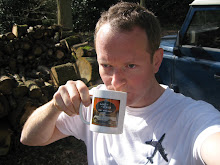 I didn't give it much more thought until Sunday breakfast when the same topic arose. Milo proposed that they were yellow because Daddy puts mustard in the scrambled eggs. Sabine had a slightly less surreal explanation. She suggested that they became yellow if Lucky sat on them. (She's our resident broody hen.)
I didn't give it much more thought until Sunday breakfast when the same topic arose. Milo proposed that they were yellow because Daddy puts mustard in the scrambled eggs. Sabine had a slightly less surreal explanation. She suggested that they became yellow if Lucky sat on them. (She's our resident broody hen.)I figured I should be able to come up with some better theories. It must have something to do with the feed and environment. Firstly, hens require a large volume of good clean water. Since eggs are mostly water and protein. These chooks have their water mains pressured to a header tank and delivered to gravity fed drinking trays.
Then there is the protein. This comes from their layers pellets which are 17% protein. The feed comes from Hi-Peak feeds in Derbyshire. They mill the cereals and package into sacks for delivery on a pallet. It is strictly non-GM and contains the following ingredients. Wheat, non-GM hi-protein soya, calcium carbonate, prairie meal, linseed, vitamins and minerals.

Your regular factory farmed free range hens stop about there. Water and layers pellets are sufficient for a healthy diet. Guerrilla hens go a little further and add two other ingredients. Mixed corn is fed ad-lib. The hens love it but it's protein content is on the low side at 10.5% and if protein intake drops then egg production can slow down. The principle components are whole wheat, split maize and organic soya oil. The maize is bright yellow!

Finally, there is fresh grass. Guerrilla Hens forage on fresh grass, a system of electric nets means that they can regularly be moved to fresh pasture. Factory farmed free range means up to 2,500 birds per hectare and very little will grow under such high stocking density.
 These Guerrilla Hens have plenty of space to rummage in the undergrowth. I believe it is the treats they find while foraging, together with the grass that gives them the depth of flavour sometimes called yellow.
These Guerrilla Hens have plenty of space to rummage in the undergrowth. I believe it is the treats they find while foraging, together with the grass that gives them the depth of flavour sometimes called yellow.

No comments:
Post a Comment